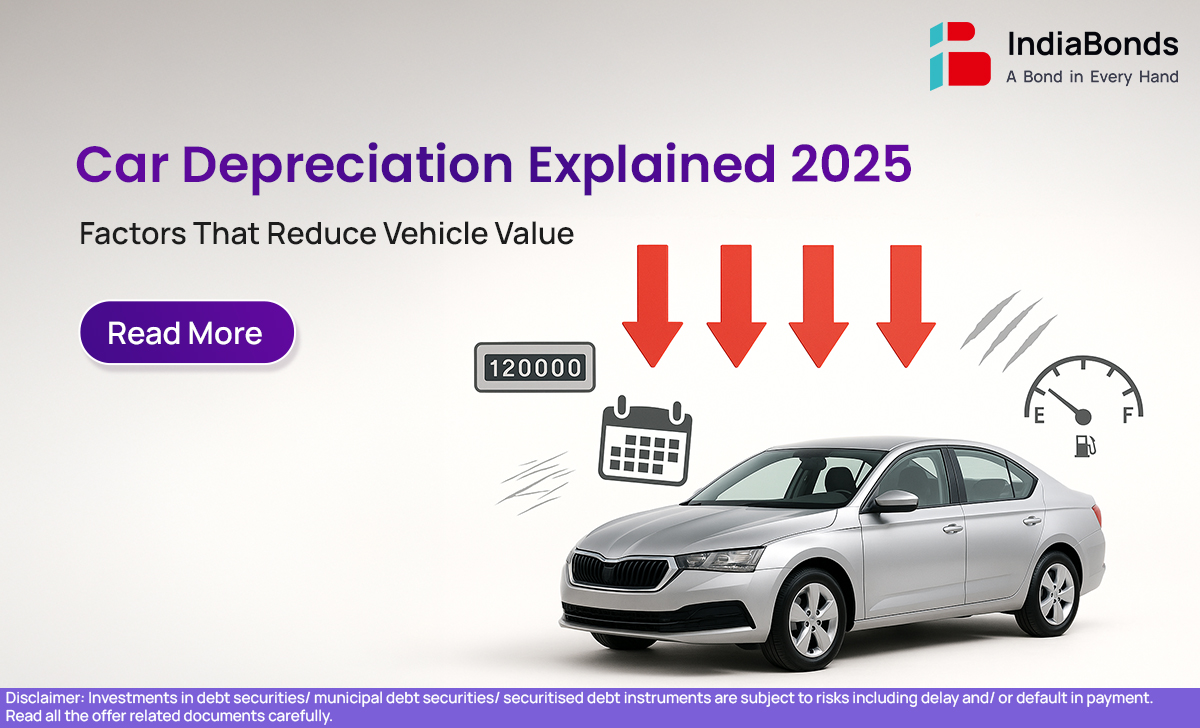Car Depreciation Explained 2025: Factors That Reduce Vehicle Value

Introduction
A young couple in Pune buys a new hatchback for ₹8 lakh. It runs fine, sips fuel politely, and never gives drama. Five years later they list it on a marketplace. Serious buyers offer ₹4.7–₹5 lakh. Nothing broke. The price still fell. That quiet fall is car depreciation—the part of car ownership most people feel only when it’s time to sell.
What is Car Depreciation?
People often ask, what is car depreciation in the simplest sense. It is the steady drop in a car’s value because it gets older, gains kilometres, and buyer taste changes. A well-kept Maruti, Hyundai, or Toyota still slides each year. The owner doesn’t pay it monthly; it shows up on the day of sale as a smaller cheque.
How is Car Depreciation Calculated for a Car?
There’s a straight, school-level way:
Yearly depreciation = (Buying price – Current market value) ÷ Years owned.
Example: A 2020 Swift bought at ₹8,00,000 sells in 2025 for ₹4,80,000.
(8,00,000 − 4,80,000) ÷ 5 = ₹64,000 per year.
A car depreciation calculator does the same math after taking model, year, kilometres, and condition. Dealers and online portals use similar logic while quoting.
Factors That Contribute to Car Depreciation
- Age: New cars fall fastest in the first 2–3 years; after that, the slide is calmer.
- Kilometres: A five-year car with 80,000 km usually sells lower than the same car with 35,000 km.
- Brand trust: Maruti, Toyota, and some Hyundai models often hold value better because spares are easy and service is everywhere.
- Fuel and gearbox: Diesel rules in Delhi-NCR or BS norms can hit resale; simple, reliable petrol manuals can do better.
- Condition: Accident repairs, mismatched paint, torn upholstery, and weak tyres speed up car depreciation.
- Service history: Authorised, on-time services slow the fall—buyers pay more for a neat file of bills.
- Model cycle: A discontinuation or a big facelift can pull older versions down.
- Running costs: Poor mileage and high insurance quotes scare buyers and reduce the price.
What is Considered a “Good” Depreciation Rate?
There is no single number, but a slower car depreciation rate is considered “good.” After the first-year drop, many mass-market cars settle around 8–12% per year. Models with reliable engines, low upkeep, and long waiting lists usually show a better (slower) car depreciation rate.
How is Car Depreciation Calculated in India?
In daily life, owners look at resale portals, dealer quotes, and insurance IDV (Insured Declared Value). A rough Indian pattern: a sharp first-year dip, then a steady slide. By year five, many cars trade at 45–55% of the original invoice, depending on brand, kilometres, and care. A quick check on a car depreciation calculator plus recent listings on portals like Spinny or CarDekho gives a practical number for a specific car and city.
Is Car Depreciation a Fixed Cost?
In accounting, yes, it is booked regularly. On the road, it behaves predictably but not fully fixed. Two identical Honda Citys from 2020 can sell differently in 2025—one single-owner car from Chandigarh with 32,000 km and clean panels will beat a rough, 70,000-km Mumbai car. Weather, traffic, and policy changes nudge the line up or down.
How to Minimize Car Depreciation?
- Choose right at purchase: Pick models with proven demand and wide service reach.
- Maintain like clockwork: Keep service schedules, save every invoice, and stick to OEM parts.
- Protect the body: Park in shade, fix dents immediately, avoid unnecessary repainting.
- Drive sanely: Smooth driving keeps clutch, tyres, and suspension healthy—buyers notice.
- Mind the kilometres: For mega highway runs, some families prefer rail or rentals to keep personal km low.
- Skip heavy modifications: Loud exhausts, oversized alloys, and flashy wraps reduce buyer pool.
- Sell with timing: List before big policy shifts or just before a major model refresh. Check ask price with a car depreciation calculator to avoid lowballing.
Final Thoughts
Every car loses value; the trick is to slow the leak. The owner who buys a trusted model, services on time, and sells at the right moment often saves lakhs over a decade. Car depreciation may be silent, but it can be managed with calm, simple habits.
What is the depreciation on vehicles in 2025?
Across Indian mass-market cars, the first year still stings the most. After five years, many settle near 45–55% of the original price, shaped by brand, kilometres, policy rules, and condition.
How does depreciation affect the value of a car?
Depreciation is the reason a car bought for ₹10 lakh may trade for ~₹6 lakh after four to five years even if it runs well. Heavy use, accidents, or poor upkeep can drag it further down.
What factors contribute to the depreciation of a car?
Age, kilometres, service history, accident repairs, brand reputation, model changes, running costs, and local rules (for example, diesel limits in NCR) together decide the car depreciation rate.
How to explain car depreciation?
It’s the invisible cost of ownership—the gap between buying price and selling price. A car depreciation calculator or the simple formula shows how much value a car is likely to lose each year.
Disclaimer : Investments in debt securities/ municipal debt securities/ securitised debt instruments are subject to risks including delay and/ or default in payment. Read all the offer related documents carefully.
































